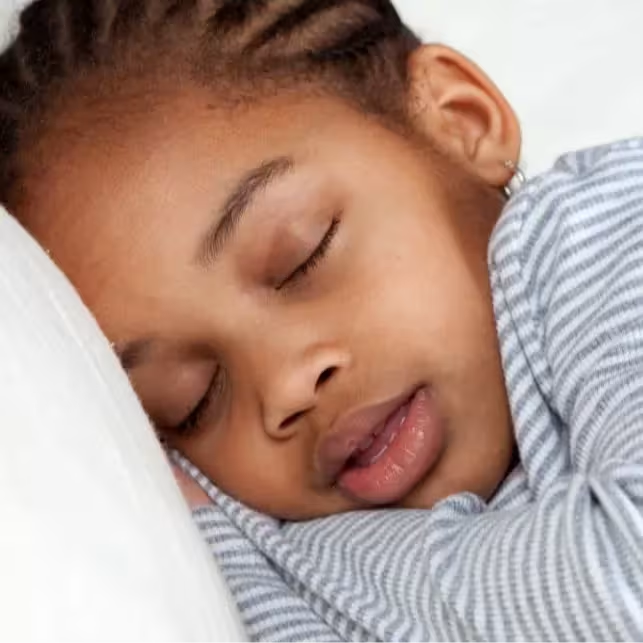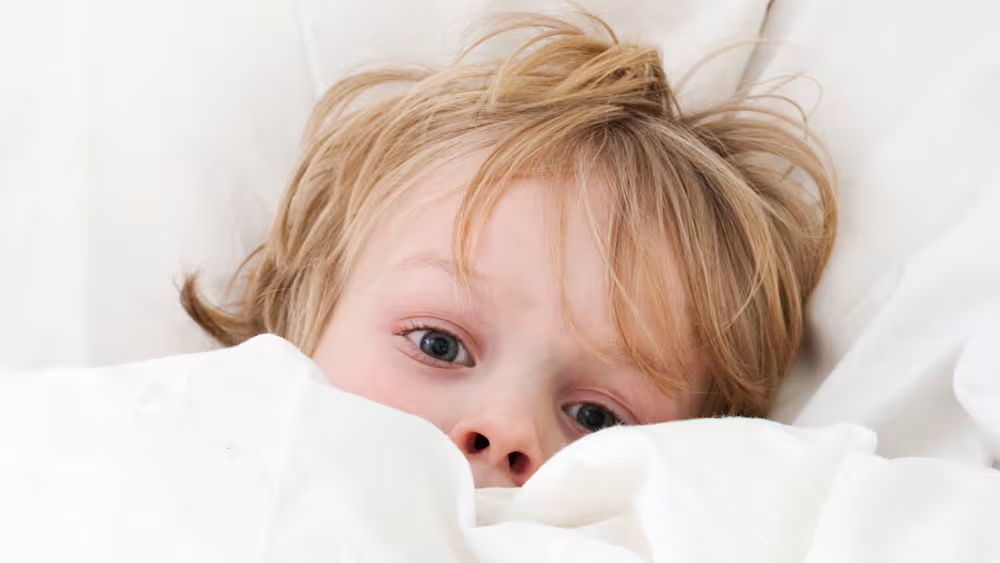Toddler nightmares: Why they happen and what to do
Updated Oct 16, 2025

From birth you may have noticed your child smiling, grimacing, or twitching in their sleep and thought to yourself, “I wonder what my baby is dreaming about?” Although it’s not clear if babies actually have dreams, we do know there is a lot of brain activity happening while babies sleep.
All this brain activity is certainly the cause for all those facial expressions and noises you’ve seen! What we do know is that toddlers DO dream and sometimes they can even experience bad dreams. If your child is waking up unsettled or has a difficult time sleeping you’re probably wondering if bad dreams could be the reason and what YOU can do to help them.
Note: Nightmares may begin as young as 6 months of age and are most frequent between 3 and 12 years old [].
Why do nightmares happen?
Just like adults, toddlers dream frequently. Oftentimes dreams are related to the day’s events, faces or objects we see, playtime, and interactions with friends and family. It is unclear about why we dream but there are studies that show dreams play a role with brain function [].
Of course, some dreams can be a bit bothersome or even wake us from our sleep. Although the exact cause of nightmares isn’t known, toddlers and older children are more likely to experience nightmares when they are overtired or experiencing stress [].
How do I help my kids with nightmares?
Some ways to help children with nightmares include:
Offering physical reassurance
Talking to your child about nightmares in an age-appropriate manner
Offering emotional reassurance
Turn on dim lighting if they don't settle after a few minutes
If your child wakes up suddenly and appears to be very shaken or scared it may be helpful to offer a comforting back or belly rub and speak to them in a soft, gentle voice.
If a gentle touch and comforting words don’t do the trick, rest assured it is OK to pick your child up and spend some time rocking and singing with them until they relax.
If your child does not settle down within a few minutes, try turning on a very dim light and talking to your child about how they’re feeling. Although babies and toddlers may have difficulty communicating what’s wrong, it is important to allow children to express themselves. Even if you don’t understand exactly what they’re saying, just keep the “lines of communication open” and offer plenty of snuggles as they settle into your arms.
Sleep tips to prevent nightmares
Here are some ways to prevent nightmares:
Maintain a consistent sleep schedule
Talk about any fears your child may have
Evaluate media your child is consuming
Find more details below:
Tip #1: Maintain a consistent sleep schedule
Since overtiredness increases the likelihood of nightmares in toddlers and baby, the best way to prevent bad dreams is to ensure your child gets to and during the day.
Tip: To encourage an age-appropriate bedtime, be sure to allow approximately 5 - 6 hours of awake time between your toddler or preschooler’s nap and bedtime. You will also want to limit daytime sleep to 2 - 3 hours.
Tip #2: Talk about any fears your child may have
Once you’ve ensured your child’s schedule is age-appropriate it is time to move on to help them with any fears they may have. Many toddlers and preschoolers develop fears as their imagination blossoms. For many toddlers, fears surrounding “monsters” or the dark are very common. Try to talk to your child about any fears they may have. Again, they may have some difficulty explaining what they’re fearful of, but simply listening is a huge comfort to children this age.
Tip: If your child is afraid of “monsters” or has unidentified fears you may want to try installing a non-blue light night-light in their bedroom. Your kiddo may want that extra security of being able to see “what is out there”!
Sleep tip #3: Evaluate media your child is consuming
Evaluate the content your child may be . Although content may be deemed suitable for young children, some shows, movies, and apps may contain images that can frighten young children. Scenes depicting a “mean” or scary character or those that are of dark skies and heavy storms can cause a potential stress response in toddlers and preschoolers.
How are nightmares different from night terrors?
There are a few key differences between nightmares and night terrors:
Nightmares usually occur more than 3 hours after your child has fallen asleep, and are often triggered by fears your child may have about things like monsters, the dark, or thunderstorms.
Night terrors happen earlier in the night, usually 1 - 2 hours after falling asleep, and occur when a child doesn’t make the transition between sleep stages properly.
When children experience a nightmare, they may whimper in their sleep, or cry out softly. Children experiencing a nightmare can be woken up and are easily consoled.
During a night terror, your child may shout or thrash in their sleep. Although it’s terrifying to witness a night terror, there’s no need to wake them. In the morning, your child will have no memory of the night terror, whereas they’re usually able to recall bad dreams.
are linked to poor sleep habits and are often triggered by not getting enough sleep, or staying awake too long before sleeping (overtiredness). In this case, it’s important to evaluate your child’s sleep schedule and make adjustments, like encouraging a daily nap and moving bedtime earlier.
Takeaway
Nightmares may start as young as 6 months of age and are most frequent between 3 and 12 years old. The exact cause of nightmares isn’t known, but toddlers and older children are more likely to experience nightmares when they are overtired or experiencing stress.
Some ways to help toddlers with nightmares include offering physical and emotional reassurance, talking to your child about them in an age-appropriate manner, and turning on dim lighting if your child is having trouble settling to sleep.
Ways to prevent nightmares include maintaining a consistent sleep schedule, talking about fears with your child, and evaluating the media they're consuming.
Note that nightmares are different from night terrors. Night terrors happen earlier in the night, usually 1 - 2 hours after falling asleep, and occur when a child doesn’t make the transition between sleep stages properly. In the morning, your child will have no memory of the night terror, whereas they’re usually able to recall bad dreams.
Nightmares FAQ
Share article:
Note: The content on this site is for informational purposes only and should not replace medical advice from your doctor, pediatrician, or medical professional. If you have questions or concerns, you should contact a medical professional.






